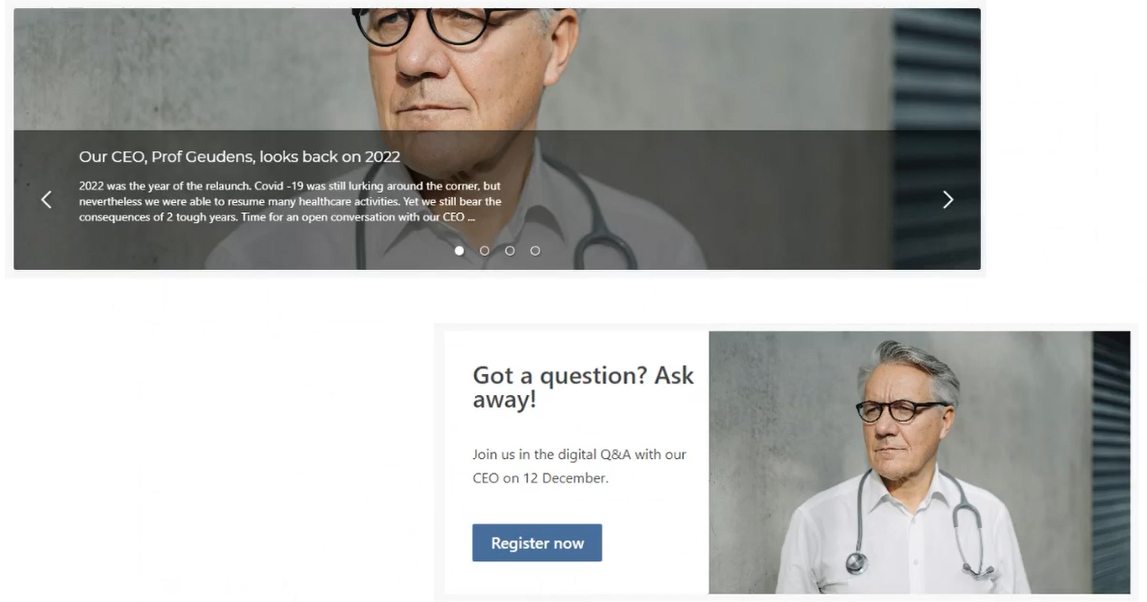Internal communication is a challenge for any organization. Especially for hospitals and healthcare organizations, it’s even harder because of the complexity of their operations and organizational structure.
Last week, our Customer Success Manager Pascal Herreweghe shared his insights on the topic.
 A brief introduction about Pascal: before joining Involv, Pascal was a Digital Communication Manager at UZ Brussel. He has more than 15 years of experience and expertise in communications from both internal and external side.
A brief introduction about Pascal: before joining Involv, Pascal was a Digital Communication Manager at UZ Brussel. He has more than 15 years of experience and expertise in communications from both internal and external side.
The webinar attracted internal communication professionals of more than 60 big hospitals and healthcare organizations in Belgium and the UK.
In case you missed the webinar, we listed the key takeaways here. If you’re curious, you can also watch the recording of the webinar here.
1. 3 common contributors to the complexity of internal communication in hospitals
Pascal shared three quotes from the book ‘Communicatie Troef’, which partly summaries the complexity faced by communication professionals in the healthcare sector.
- Work pressure increases and, at the same time, employees face an information overload.
- In a healthcare organization you will find a lot of different profiles.
- A lot of employees do not have a desk or their own PC.
2. How does Involv intranet address this?
Involv is a modern intranet platform that is designed to help (not only) healthcare organizations tackle the above-mentioned problems. Here are some of the reasons why many hospitals in Belgium are using Involv to support their communication strategy:
- Ability to deliver the right message to the right people at the right time (targeted communications), to avoid information overload
- Ability to reach everyone where they are, on their preferred platforms whether it’s via smartphone, desktop, digital signage, Teams or email (omnichannel approach)
- Ability to ensure that important information is read (push notifications via different channels)
- Ability to personalize information flows by employees (preferences)
3. Digital communication is not always the answer.
Especially in hospitals, to ensure information is spread effectively, the communication channels and means must be clearly defined in advance. And this matrix is driven by both the hospital structure, and the urgency and complexity of the information. Having said that, digital communication indeed has its limits.
In some cases (important, sensitive personal information), a more personal approach such as cascading information via line managers is needed.
In other cases – for example when the message to be shared is complex – organizing an info session is also an effective way to make sure that everyone is on board.
In both cases, the IC team has an important role to play by creating presentations, putting together FAQs, coaching, etc.
4. Use of ambassadors
Among many different profiles in hospitals, doctors form an exceptional group as they are much more difficult to reach than others. One best practice for communicating with doctors is ensuring two-way communication: listen to their opinions, ask them for feedback about hospital policies, share their complaints.
Another effective way to reach doctors is via other doctors. Communication ambassadors among doctors are very valuable to help convey important messages to their peers.
5. It’s okay to push the pause button.
In reality, IC teams in hospitals receive plenty of requests to communicate something to employees. So, it’s vital that your IC team carefully considers every request. Is this communication necessary to publish? Your organization’s objectives are one of the sources you can base on to evaluate the necessity of a message. Does it support the hospital’s objectives? If yes, then the next question should be about the target audience of your message. To which target groups does the information need to be communicated? And of course, how. Which channels will you use?
Make sure that employees see the value of your communication. Unnecessary or irrelevant communication can cause your communication to drown or be ignored in the future.
6. The intranet as a front door
Each kind of information has its place and time to be shared. Especially for hospitals, to ensure the information flow, it’s important to clearly define what channels or platforms are used to communicate what information. Make sure your employees know this so they know exactly where to find what they need.
Your intranet can be a great front door where employees can easily access all their favorite platforms and tools. Everything is centralized and made easily accessible inside the intranet whether it’s information from Outlook, SharePoint, OneDrive, Planner, Yammer, etc. Involv even offers integration options for Zenya, a quality management tool used in a lot of hospitals.

7. Communication to foster a strong culture
In the last part of his presentation, Pascal shared some tips and best practices on how to foster a healthy culture.
- Have a place for employees to have conversations and connect.
- Bring the hospital’s culture to life through photos, images, stories and insights from departments and teams. Share success stories.
- Help colleagues remember why they chose a job in the healthcare sector (purpose!) by sharing colleagues’ motivations via personal stories.

- Make leadership communication more on display to create transparency, build trust and show empathy. An effective way is organizing (digital) Q&A sessions where employees can engage in direct dialogue with their management team.

- Create a great onboarding experience for new employees.

And it’s absolutely possible to implement these practices within Involv thanks to its package of features:
- You can easily add Yammer conversations into your intranet.
- You can make your intranet more like a social network where employees can like, comment, and mention @collegues.
- You can publish any kind of content on the intranet to make your communication more visual.
- You can change the styling, or even create your own design to make the intranet yours.
- You can survey employees and organize Q&A sessions in a digital way so that everyone can attend and engage with.
- You can bundle all necessary information for new employees in one place, welcome them onboard etc.
8. Don’t lose sight of mental and physical health
Working in a hospital is mentally and physically demanding. Moreover, many health workers today still bear the effects of the pandemic.
Your communication strategy should therefore include highlighting the importance of resilience, sharing tips and best practices of selfcare and wellbeing, as well as offering practical support.
An effective way to understand your employees’ resilience is by doing surveys on a regular basis. However, don’t do this if you’re not willing to be transparent about the result as well as to follow up after the survey. For internal communication to work, it must be authentic and transparent.

We hope that you find these takeaways useful. Again, if you’re curious, you can watch the recording of the webinar here. And if you want to know more about Involv, feel free to contact us for a short demo or more information.


